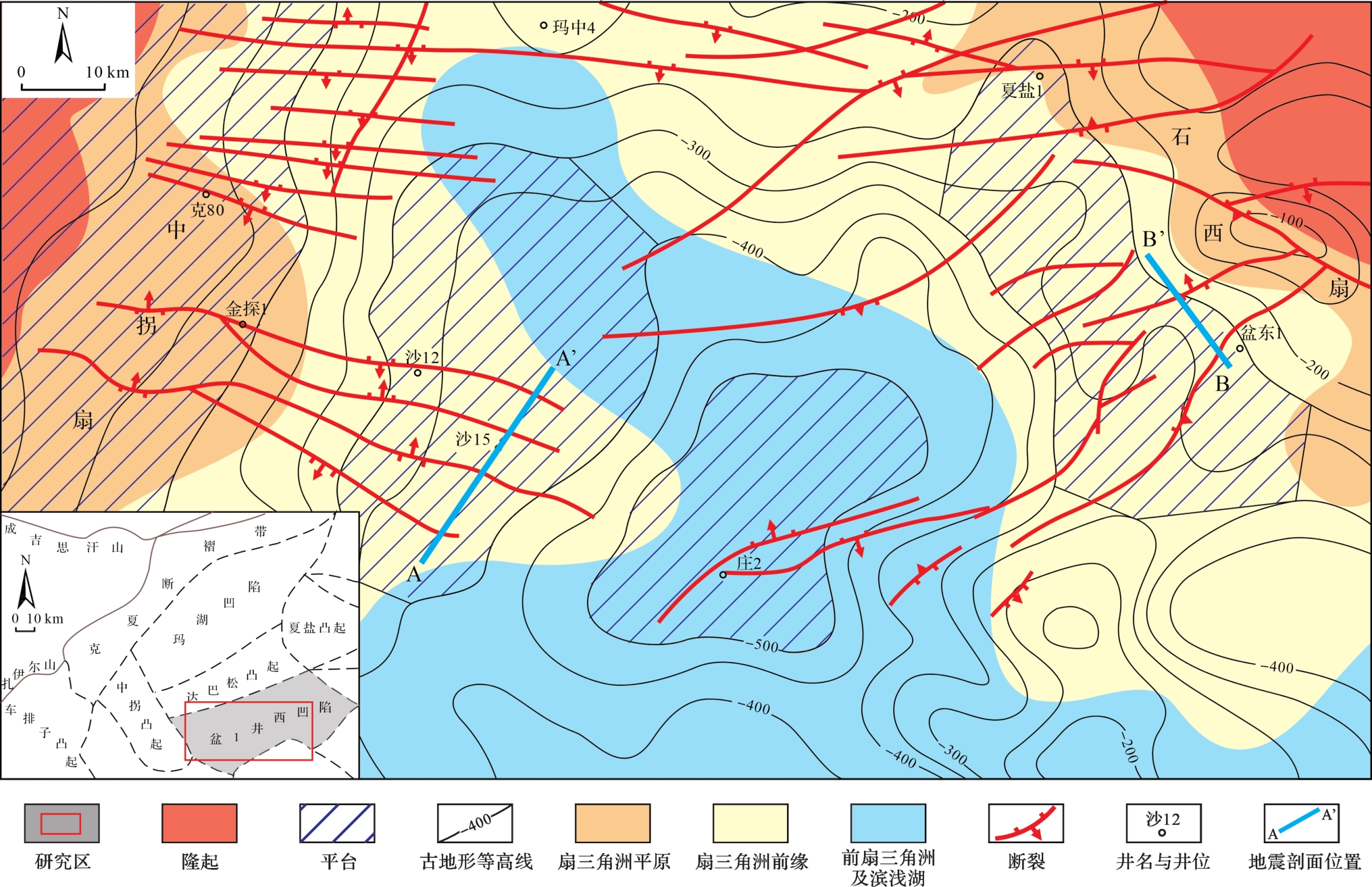-
近年来,新疆油田根据玛湖凹陷的勘探实践,提出了退覆式浅水扇三角洲沉积模式[1],根据这一模式,在玛湖凹陷上乌尔禾组和百口泉组发现三级地质储量超过10×108 t[2]。该沉积模式最重要的特点之一是砂砾岩储层满盆分布,形成这一特点的关键因素是“山口主槽,控扇延展”[1],即山口和主槽是向凹陷中心输送粗碎屑的有利通道,它们的分布控制了扇体的展布,而主槽受控于主断裂,且部分次级断裂也控制了次级沟槽的分布,为粗碎屑的搬运提供通道[3]。因此,从根本上说,断裂的分布对扇体的展布有重要的控制作用。
在百口泉组沉积时期,盆1井西凹陷与玛湖凹陷同属于准噶尔盆地相邻的两个部分[4],中石化在该凹陷中部的庄2井也发现了厚层的含砾粗砂岩。参照玛湖凹陷勘探实践推测,这些粗碎屑能够从物源区经长距离搬运至凹陷中心,断裂构成的通道起到了重要的导流作用。不同断裂组合对粗碎屑的导流效率是有差异的,哪种断裂组合导流能够更快地将粗碎屑从源区搬运至凹陷中心,关系到凹陷中心粗碎屑来自凹陷东侧的石西扇还是西侧的中拐扇,直接影响到以后的勘探方向。目前学界关于断裂对扇体影响的研究主要侧重于断裂对扇体演化与分布的控制[5⁃8],而断裂组合导流对扇体形态的影响、对粗碎屑长距离搬运的控制作用研究较少[3]。因此笔者结合研究区的地质特征,通过一系列沉积物理模拟实验对这一问题进行了探索。
-
准噶尔盆地处于哈萨克斯坦板块、西伯利亚板块和塔里木板块之间,是晚古生代至中、新生代持续发育的多旋回叠合盆地[9]。盆地大致经历了二叠纪前陆盆地、三叠纪到白垩纪内陆坳陷盆地、古近纪以后前陆盆地等多个演化阶段[10]。在西北、东北方向的挤压、压扭作用下,盆地边缘形成了大型的边界断裂,海西中期至喜马拉雅时期,因应力调整派生出一系列与边界断裂近于垂直或大角度相交的走滑断裂[11]。
盆1井西凹陷位于准噶尔盆地中央坳陷区,北部与玛湖凹陷以达巴松凸起相隔。在三叠纪百口泉组沉积时期,盆1井西凹陷与玛湖凹陷是统一的内陆坳陷盆地的两个部分[4]。该时期发生持续湖侵[1,12⁃15],来自西侧盆缘造山带与东侧陆梁隆起的物源[16],在盆1井西凹陷中形成了广泛的扇三角洲沉积体系[17]。
该凹陷中石化探区目前处于勘探早期,探井4口,取心16.4 m,百口泉组地震资料品质较差,但在多层系见良好的油气显示,预示了良好的勘探前景[17]。
-
地质模型的重建是进行沉积物理模拟实验设计的基础,以下将从古地形特征、断裂分布特征、流体性质和湖平面变化等4个方面对其进行阐述。
-
胜利油田勘探开发研究院结合地震解释,根据印模法恢复了盆1井西凹陷百口泉组的古地形(图1)。该古地形具有多级平台—坡折的特点,从西侧向凹陷中部,中拐扇依次经历了三个平台,从东侧向凹陷中部,石西扇经历了两个平台,平台的坡度大致在0.5°~1.5°,平台与平台之间为坡度较大的坡折(图1)。
-
盆1井西凹陷西侧断裂为近于平行的线形,其走向与沉积体系的展布方向较为一致,东侧的断裂呈人字形交叉,为弧形,它们与盆地边界断裂近于垂直或大角度相交(图1)。它们是盆地边界断裂活动时,由于横向应力调节而派生出的高角度走滑断裂,形成于海西中期以后,断距很小,有的地震剖面上甚至没有明显的断距(图2),这些特征与玛湖凹陷是一致的[9,11,18]。

图 2 T2k层拉平地震剖面上的平行断裂(a)和交叉断裂(b)(剖面位置见图1)
Figure 2. The parallel⁃faults (a) and cross⁃faults (b) in the seismic section of T2k (section locations are marked in Fig.1)
准噶尔盆地印支运动的区域主应力主要来自西北和东北[19],向南构造应力逐渐减小,这一特征体现在从玛北到玛西再到玛南断裂的密度逐渐减小[11,18],在盆1井西内部也延续了这一趋势(图1)。由此推测,盆1井西凹陷断裂活动要比玛湖凹陷弱得多,其走滑断裂平移距离远小于玛湖凹陷的走滑断裂。因此,盆1井西凹陷走滑断裂平移对扇体的影响较小,其对扇体的控制主要通过断裂作为供源通道来实现,这正是本次模拟实验的关注点。
-
百口泉组沉积时期,准噶尔盆地为干旱—半干旱气候[20⁃22],容易暴发阵发性洪水和泥石流,流体性质为重力流(主要是泥石流)和牵引流,形成的扇体具有旱扇的特点。
该区岩心有泥岩、泥质中粗砂岩、含砾泥质中粗砂岩、泥质砂砾岩,以粗粒岩性为主;结构上粗细混杂,分选差,砾石以棱角状、次棱角状为主;常见基底式胶结、杂基支撑结构(图3a),颗粒漂浮在杂基中,特别是长条形颗粒竖立在杂基中(图3b),说明沉积物在搬运过程中快速堆积。沉积构造以块状层理、递变层理为主(图3a~c),递变层理以20~30 cm厚最为常见,且反复出现,说明流体具有阵发性特征,能量不稳定,变化频繁。据以上特征判断,流体性质为泥石流。沙12井的粒度概率累积曲线主要表现为宽缓的上拱弧形(图4),根据典型的粒度概率累计曲线[23]判断,为颗粒或杂基支撑悬浮搬运,即典型的泥石流。

图 3 沙12井百口泉三段岩心特征
Figure 3. Core characteristics for the Third member of the Baikouquan Formation in well Sha 12

图 4 沙12井百口泉三段粒度概率累计曲线
Figure 4. Probability cumulative grain size curve of the Third member, Baikouquan Formation in well Sha 12
部分岩心可见冲刷充填构造(图3d),冲刷面之上的粒度较冲刷面之下的细,分选要好,为河道沉积,为牵引流的沉积结果。除此之外,没有发现其他典型的牵引流特征,这可能与取心较少有关(该区只有沙12井一口井的取心,合计16.4 m),但是在邻区玛湖凹陷同一层位的岩心中发现槽状交错层理、板状交错层理,为典型的牵引流沉积构造[24]。由此推测,本区也应当发育牵引流沉积。
-
百口泉组沉积时期,玛湖凹陷与盆1井西凹陷为统一的盆地,经历了共同的湖平面升降过程。参照前人对玛湖凹陷的研究,认为百口泉组整体为一个水体加深不断湖侵的过程[1,12⁃15]。
-
在明确研究区地质条件的基础上,依托中国石油天然气集团公司油气储层重点实验室—长江大学湖盆沉积模拟实验室,笔者设计了一个具有三级平台—坡折的底形,分别用于模拟三级平台—坡折背景下无断裂、平行断裂和交叉断裂条件下的扇体沉积形态,然后将3种实验所测得的扇体几何参数进行对比,研究不同断裂组合对扇体形态的影响。
-
设计的模拟实验水池长5.5 m、宽3.0 m、深0.8 m,最低处为0.5 m宽0.1 m深的水池,用于排水和补水以控制水位变化(图5)。从低处向高处依次为一级平台(2°)、二级平台(5°)和三级平台(8°),各平台之间设有垂直高差为8 cm的坡折;一级、二级和三级平台长度分别为2 m、1.5 m和1.5 m,宽度均为3 m(图5)。为方便物料桶中的流体流出到各级平台沉积,在二级和三级平台上均设有导流槽,每个平台导流槽的上游较浅下游较深。

图 5 多级平台—坡折模拟实验底形设计
Figure 5. The design of the simulation pool with a multi⁃stage platform and slope break
一级平台、二级平台和三级平台的坡度依次增加,符合研究区从盆向源坡度逐渐增加的特点;另外,各平台的坡度相对于研究区而言都有所增加,是因为实验室的水沙关系(水动力与沙粒大小和重量的关系)不是自然界的水沙关系的等比例缩小,沉积物理模型是变态模型,如果平台坡度与研究区平台坡度一致,则在实验条件下,水流难以将碎屑物质向前搬运,因此,设计各级平台坡度比研究区平台的坡度大,这也是国外沉积模拟实验中的通行做法[25⁃26]。
为了对比,对多级平台—坡折基础底形进行改造,设计了3种底形的实验。
(1) 三级平台—坡折无断裂导流实验
该实验底形上左右两侧设置两个物源(设置两个物源主要是因为实验场地有限,在实际地质条件中,如果向上游追溯,两个物源是来自一个物源),分别对应两个平行的间隔1 m的导流槽。在一级平台开始实验前,将一级平台上的导流槽填平,二三级平台上的导流槽保留(图6a);在二级平台开始实验前,则将二级平台的导流槽填平,三级平台上的导流槽保留;在三级平台开始实验前,将三级平台上的导流槽填平。保留的导流槽只是作为通道将碎屑物质输送到下一个平台上沉积;作为沉积场所的平台,其上的导流槽被填平后,导流槽对扇体的展布没有影响。因此,这个底形上的实验相当于无导流槽实验,用于模拟无断裂条件下扇体的发育形态,并将其与另外两个实验对比,分析不同断裂组合对扇体形态的影响。

图 6 多级平台—坡折模拟实验底形(图中白尺长30 cm)
Figure 6. The bedforms with a multi⁃stage platform and slope break (the length of white ruler is 30 cm)
(2) 三级平台—坡折平行断裂导流实验
在实验(1)底形的基础上,各平台实验前,保留导流槽,无需填平(图6b),以此模拟平台上平行断裂对扇体形态的影响,同样也设置左右两个物源(设置两个物源的原因同实验(1))。
(3) 三级平台—坡折交叉断裂导流实验
人字形交叉断裂导流实验底形上,一级平台断裂跨度1 m;二级平台断裂在坡折处跨度1.5 m;三级平台断裂在坡折处跨度2 m(图6c),实验过程中,各导流槽均不需填平,物源直接在各级平台人字形的交叉点释放。该实验用于模拟交叉断裂对扇体形态的影响。
-
根据研究区的岩心资料(图3)、粒度分析(图4)以及参照玛湖凹陷的沉积物理模拟实验[13],笔者设计了重力流和牵引流交替来模拟扇三角洲的建造过程。
重力流中清水体积为60%,泥沙体积为40%,其中含砾粗砂、中细砂、粉砂、泥浆(泥浆中黏土主要成分是高岭石和伊利石,含量80%~90%)之间体积比是9∶11∶5∶15,泥沙比为0.6。泥沙水放置于物料桶中,用搅拌器充分搅拌,然后打开物料桶的阀门直接排放,流量约为0.91~1.05 L/s,流速约为1.22~1.44 m/s,12 ℃~15 ℃条件下黏度为2.6~3.5 mpa·s,直到排放完毕,才停止搅拌(图7a)。

图 7 性质不同的流体的沉积过程(图中白尺长30 cm)
Figure 7. Deposition process of fluids with different properties (the length of white ruler is 30 cm)
牵引流是通过物料桶释放循环水(从实验池将水抽到物料桶,再通过物料桶的阀门释放),在这一过程中,需根据扇体的沉积、冲刷情况,在物料桶出水口间歇性地加入一些中细砂,确保输沙平衡。牵引流持续时间约为30 min,流速为0.46 ~0.73 m/s(图7b)。
-
双物源无断裂实验和平行断裂导流实验中,单个物源的重力流每轮供源50 L,每个平台上做三轮实验;单物源交叉断裂导流实验每轮重力流供源75 L,每个平台上做4轮实验。这样,每个平台所沉积的重力流供源都是300 L,便于不同实验之间进行对比。每一轮实验包括一次重力流沉积和一次牵引流改造。每个平台上每一轮实验结束后,测量扇体的长度和宽度,计算长宽比。
所有实验都是模拟整体水位上升、湖侵的过程,虽然不同实验的水位控制略有差异,但基本与平行断裂导流实验中水位变化相同(表1)。各级平台实验开始时,水位均在平台坡底附近,每轮实验中重力流过程持续95~110 s;重力流沉积结束后,水位抬升1~2 cm(相当于湖侵),然后开始牵引流改造,这一阶段持续时间约为30 min,牵引流改造过程中,水位缓慢下降,扇体逐渐向盆地方向进积。各级平台上后一轮沉积的初始水位比前一轮沉积的初始水位略高,模拟小范围的湖侵。一级平台结束后水位抬升至二级平台坡底开始二级平台的沉积,从一级平台到二级平台的过渡是一个快速湖侵的过程,二级平台到三级平台也是如此。
表 1 平行断裂导流实验参数
实验期次 流体性质 重力流沉积 牵引流改造 平台 轮次 持续时间/s 起始水位/cm 流速/(m/s) 持续时间/min 水位/cm 流速/(m/s) 一级平台 第一轮 95 0 1.38~1.42 30 2~0 0.46~0.58 第二轮 105 1 1.24~1.28 30 3~1 0.48~0.52 第三轮 100 2 1.22~1.38 30 5~3 0.46~0.73 二级平台 第一轮 95 15 1.42~1.44 30 19.5~16.5 0.47~0.67 第二轮 105 16 1.36~1.38 30 20~17 0.48~0.71 第三轮 100 17 1.42~1.44 30 21~18 0.49~0.70 三级平台 第一轮 110 39 1.40~1.42 30 40~37 0.46~0.69 第二轮 105 40 1.36~1.38 30 41~38 0.48~0.72 第三轮 105 41 1.42~1.44 30 42~39 0.51~0.73 注: 每一级平台的第一轮实验扇体是没有入湖的,此后水体逐渐上升代表湖侵。 -
从扇体的最终形态来看,无断裂导流形成的扇体沉积范围最广,扇体横向展布最为发育,随着平台坡度的增大,扇体的长度依次增加,宽度依次减小,长宽比依次增大(图8a、图9)。

图 8 多级平台—坡折模拟实验结果图(图中白尺长30 cm)
Figure 8. Simulation results on the bedforms with a multi⁃stage platform and slope break (the length of white ruler is 30 cm)

图 9 多级平台—坡折模拟结果参数分布特征
Figure 9. Parameter distribution of simulation results on the bedforms with a multi⁃stage platform and slope break
平行断裂导流形成的扇体,其长度、宽度、长宽比与平台坡度的关系与前一实验一致,但平行断裂导流实验各级平台上扇体的长度均比前一实验大,宽度均比其小,长宽比均比其大(图8b、图9)。
交叉断裂导流形成的扇体,其长度、宽度、长宽比与坡度之间没有明显的相关性(图8c、图9),长宽比总体处于0.79~0.87,特别是三级平台(8°)上扇体的长度、宽度、长宽比与一级平台(2°)的基本相当。
-
平台无断裂作导流槽时,进入平台区的碎屑物质自由堆积,向各个方向自由扩展(图10a~c)。牵引流对扇体的改造有限,扇体主要是由重力流建造的,而重力流是靠重力沿下坡方向的分力来驱动的,因此,平台坡度越大,沿下坡方向的分力越大,重力流运动的速度越快,形成的扇体越长,相应的宽度也就越小、长宽比越大(图9)。平台坡度对扇体形态的这种影响也存在于另外两个实验中。

图 10 无断裂导流与平行断裂导流时一级平台第一轮重力流沉积过程中各时刻形态对比
Figure 10. Comparison of morphology at different times during the first run of gravity flow deposition on the first platform between unfaulted and parallel⁃fault restricted flow
平行断裂导流实验形成的扇体,比无断裂导流条件下形成的扇体长度更大、宽度更小、长宽比也更大,很显然造成这种差异的原因是平行断裂的存在。平行断裂的走向与流体运动方向几乎一致,是碎屑物质的搬运通道(图10d~f),通道可聚流,使通道内动能更强、碎屑物质的搬运效率更高,有利于扇体的延伸。在物源供应量一定的条件下,长度增加,宽度必然较小,从而使长宽比增加。不仅如此,随着平台坡度的增加,该实验与无断裂导流实验中对应平台上扇体的长度之差越来越大(图9a),说明坡度越大,平行的线形断裂的导流作用越明显。
人字形交叉断裂的走向与流体的主要运动方向存在夹角θ(图11),因此,交叉断裂作为搬运通道,在将碎屑物质向下游搬运的同时,还要将其向两侧搬运。当θ小于45°时(实验中交叉断裂最大跨度2 m,平台最小长度1.5 m,因此实验中所有θ都小于45°),仍以纵向导流为主、横向导流为辅,表现为以扇体的延长为主、展宽为辅;当θ趋于0°时,交叉断裂就变成了平行断裂,此时纵向导流效率最高,横向导流效率最低,扇体的延长非常明显。
综上所述,将三种情况进行比较可知:无断裂导流时,扇体的延长最弱,展宽最明显;平行断裂导流时,扇体延长最明显,展宽最弱;交叉断裂导流时,扇体延长和展宽都居中。
-
按照前述结论,平行断裂导流形成的扇体的长宽比应该大于交叉断裂导流形成的扇体,但实验结果却是相反的,不仅后者的长宽比大于前者,而且后者的长度也大于前者(图9)。
平行断裂导流实验和交叉断裂导流实验形成的扇体都是多轮流体作用下的复合扇体,都可分为断裂被填满前和被填满后两个阶段。断裂被填满前,断裂是在发挥导流槽作用的,对扇体的形态有明显影响,这一阶段的实验才是真正意义上的平行断裂导流实验和交叉断裂导流实验。断裂被填满以后,断裂的导流作用就消失了,这一阶段实际上就是无断裂导流实验。因此,实验(2)包括平行断裂导流实验和无断裂导流实验,实验(3)包括交叉断裂导流实验和无断裂导流实验,相应的,这两个实验形成的扇体都是由有断裂控制的扇体和无断裂控制的扇体的叠加。由于先成扇体的堆积占据了原断裂及其上方的可容空间,不受断裂影响的非限定性河道只能寻找其他可容空间进行堆积,主要堆积在先成扇体的两侧,即原断裂的两侧。因此,综合结果表现为复合扇体相对于断裂导流形成的先成扇体变宽了。
平行断裂导流实验中导流槽的间距是1 m,交叉断裂导流实验中一级平台上断裂跨度也是1 m,二者一级平台上扇体宽度的基础是相同的,可进行对比分析。平行断裂导流实验的一级平台,大约经过5 s导流槽就被填满(图10d),5 s以后导流槽的纵向导流功能消失,其后的实验都与无断裂导流相同;而交叉断裂导流实验的一级平台经过一轮(一轮重力流95~110 s)才基本填满(图12),之后的实验也与无断裂导流相同。虽然交叉断裂的纵向导流效率不如平行断裂的效率高,但交叉断裂发挥导流作用的时间远远长于后者,这种“龟兔赛跑”的效应是其扇体长度大于后者的主要原因。当然,供源量相同,扇体长度大,宽度自然就小,长宽比也就较大了。
平行断裂导流实验二级平台上导流槽被填满的时间与一级平台基本相当(大约5 s),但交叉断裂导流实验二级平台上断裂需要2轮实验才填满(约3 790 s)(图12),因此,按照上述“龟兔赛跑”的逻辑推测,后者扇体的长度应该比一级平台扇体更长。但交叉断裂导流实验二级平台上断裂跨度是1.5 m,超过一级平台0.5 m,θ比一级平台更大,使其横向导流效率得到提升,这在一定程度上抵消了本应得到加强的纵向导流效率,最终二级平台上扇体长度略小于一级平台,二者几乎是相等的。
尽管三级平台上交叉断裂跨度是2 m,是一级平台的2倍,超过二级平台0.5 m,θ比一二级平台都大,其横向导流效率应超过一级和二级平台,在相同时间内能更大程度地减弱纵向导流效率,可能形成一个比一二级平台长度更短的扇体。但是,三级平台的θ仍然小于45°,纵向导流效率虽然有所降低但仍高于横向导流,扇体仍以延长为主,另外,三级平台上断裂经过3轮才填满(约5 690 s)(图12),其经历的纵向导流时间比一二级平台都长。因此,在时间的加持下,三级平台上仍有可能形成一个长度较大的扇体,实验结果显示,其长度达到1.91 m,超过了一二级平台上扇体的长度。同时这一长度也超过了平行断裂导流实验三级平台上的扇体(三级平台上的平行断裂只经历了几秒钟便被填满)。
最终,交叉断裂导流形成的扇体长宽比为0.79~0.87,没有明显的变化趋势,且其长度都大于平行断裂导流形成的扇体。
从以上分析可知,有断裂导流条件下形成的复合扇体其长宽比要大于无断裂导流形成的扇体,且在相同条件下,交叉断裂导流形成的扇体的长宽比要大于平行断裂导流形成的扇体,形成这一特征的原因主要取决于断裂作为通道控制扇体的时间长短。
-
研究区的真实情况要比实验设计的复杂得多,但由于研究区勘探程度很低,地质信息非常有限,只能依据有限的信息进行实验设计,抓住主要因素开展模拟,这是模拟实验中存在的客观问题。实验模型不是研究区原型的等比例的缩小,也无法通过等比例放大的方式将实验形成的沉积体放大到研究区中,并以此作为寻找有利目标的依据。模拟实验的目的在于在尽可能贴近实际情况下,开展机理性的研究。因此,尽管研究区供源西强东弱,但为了便于比较,实验设计的东西两个物源总供源量相同。
在研究区目前钻井极少、地震品质较差的情况下,研究断裂组合导流控扇这一问题,对于研究退覆式浅水扇三角洲中粗碎屑长距离搬运的机制、明确凹陷中部粗碎屑的来源(来自西侧的中拐扇还是东侧的石西扇)、评估能否在凹陷中部找到大面积的砂砾岩储层,具有重要的参考意义。
-
基于沉积模拟实验对盆1井西凹陷百口泉组断裂组合导流作用对扇三角洲形态影响的研究,取得以下结论。
(1) 垂直于或与边界断裂大角度相交的走滑断裂对扇体的形态有明显的控制作用。所有的实验表明,无论其是平行断裂还是交叉断裂,有断裂导流的扇体,其长宽比都大于无断裂导流的扇体,这是断裂导流作用的结果。
(2) 在断裂发育的底形上,复合扇体的发育通常经过断裂导流和无断裂导流两个阶段。在断裂导流阶段,平行断裂的纵向导流效率较高,形成扇体的长宽比大于交叉断裂条件下的扇体;断裂填满以后,扇体的发育不受断裂的影响,相当于无断裂导流。
(3) 在其他条件相同的情况下,平行断裂导流形成的复合扇体的长宽比要小于交叉断裂导流形成的复合扇体,但复合扇体的长宽比不取决于断裂组合形态,而取决于断裂控制流体定向流动的时间长短,即在物源供应充足的条件下,长时间没有填满的断裂,更容易将粗碎屑运移到盆地中心,形成长宽比较大的扇体。
Influences of Restricted Flow by Fault Assemblage on Fan Delta Morphology: Evidence from a depositional physical simulation experiment of the Baikouquan Formation in the Well Pen-1 West Sag, Junggar Basin
-
摘要: 断裂组合导流如何控制扇体的几何形态、哪种断裂组合有利于将碎屑物质搬运至盆地中心,是准噶尔盆地盆1井西凹陷百口泉组勘探初期面临的重要难题之一。针对这一问题,运用沉积物理模拟实验的方法,结合研究区地质背景,设计了一个具有三级平台—坡折底形的实验池,开展无断裂、平行断裂和交叉断裂条件下扇三角洲沉积模拟实验。实验结果表明:断裂组合类型是控制扇体形态的关键因素,与边界断裂大角度相交或近于垂直的平行断裂和交叉断裂对扇体的形态都有明显的控制作用,受控的扇体有较大的长宽比;在断裂组合控制下,复合扇体的发育通常经过断裂导流和无断裂导流两个阶段;在物源供应充足且供应量相同的条件下,平行断裂导流形成的复合扇体的长宽比要小于交叉断裂导流形成的复合扇体;此外,断裂组合对扇体形态的影响还取决于断裂控制流体定向流动的时间长短,长时间没有填满的断裂,更容易将粗碎屑运移到盆地中心,形成长宽比较大的扇体。该研究揭示了沉积盆地中不同断裂组合对扇体发育的可能影响,研究结果对于指导盆1井西凹陷百口泉组的碎屑岩储层预测具有参考意义。Abstract: An important issue in the early exploration of the Baikouquan Formation in the Well Pen-1 West Sag, in Junggar Basin concerns how the fault assemblage restricted flow influences the geometry of the fan delta morphology and which fault assemblage is beneficial for transporting detrital materials to the center of the basin. The authors designed an experimental pool with a three-stage platform and slope break bedform for a depositional physical simulation experiment, based on the geological background of the study area, and conducted a series of fan delta depositional simulation experiments with unfaulted, parallel-fault, and cross-fault assemblages. The experimental results show that the fault assemblage type is the key factor controlling the geometry of the fan delta morphology. The parallel-fault and cross-fault with large angle intersection or nearly vertical to the boundary fault exert obvious control on fan delta morphology, and the controlled fan shows a large length-width ratio in geometry. Based on fault assemblage, the formation of the composite fan consists of two stages: one is a restricted flow with faults and the other unfaulted. When the provenance is sufficient, the length-width ratio of the composite fan formed by parallel-fault restricted flow is less than that formed by the cross-fault restricted flow. In addition, the influence of fault assemblage on fan morphology also depends on the directional flow time of the fault controlled fluid, i.e. the faults that have not been filled for a long time more easily transport coarse fragment to the basin center and form a fan delta with a large length-width ratio. This study reveals the possible influence of different fault assemblages on fan development in a sedimentary basin. The research results provide reference for the prediction of clastic reservoir formation from the Baikouquan Formation in Well Pen-1 West Sag.
-
图 3 沙12井百口泉三段岩心特征
(a)块状层理,杂基支撑,5 131.5 m;(b)块状层理,杂基支撑,长条形颗粒竖立,5 131.3 m;(c)叠置的递变层理,5 129.5 m;(d)切割冲刷,5 132.4 m
Figure 3. Core characteristics for the Third member of the Baikouquan Formation in well Sha 12
(a) matrix⁃supported, massive pebbly sandstone, 5 131.5 m; (b) matrix⁃supported, massive pebbly sandstone, vertical strip grains, 5 131.3 m; (c) superimposed graded bedding, 5 129.5 m; and (d) cutting and scouring, 5 132.4 m
图 8 多级平台—坡折模拟实验结果图(图中白尺长30 cm)
(a)无断裂导流模拟结果;(b)平行断裂导流模拟结果;(c)交叉断裂导流模拟结果
Figure 8. Simulation results on the bedforms with a multi⁃stage platform and slope break (the length of white ruler is 30 cm)
(a) simulation results on unfaulted bedform; (b) simulation results of parallel⁃fault restricted flow; (c) simulation results of cross⁃fault restricted flow
图 9 多级平台—坡折模拟结果参数分布特征
(a)平台坡度与扇体长度的关系;(b)平台坡度与扇体宽度的关系;(c)平台坡度与扇体长宽比的关系
Figure 9. Parameter distribution of simulation results on the bedforms with a multi⁃stage platform and slope break
(a) relationship between platform gradient and fan length; (b) relationship between platform gradient and fan width; (c) relationship between platform gradient and fan length⁃width ratio
图 10 无断裂导流与平行断裂导流时一级平台第一轮重力流沉积过程中各时刻形态对比
(a~c)无断裂导流的第5 s、25 s、45 s时扇体形态;(d~f)平行断裂导流的第5 s、25 s、45 s时扇体形态,白尺长30 cm
Figure 10. Comparison of morphology at different times during the first run of gravity flow deposition on the first platform between unfaulted and parallel⁃fault restricted flow
(a⁃c) are fan morphology of the unfaulted bedform at 5, 25, and 45s; (d⁃f) parallel⁃fault restricted flow, the length of white ruler is 30 cm
图 11 交叉断裂导流的分解
交叉断裂跨度越大,θ越大,横向导流越明显,θ超过45°则以横向导流为主;交叉断裂跨度越小,θ越小,纵向导流越明显,θ小于45°则以纵向导流为主;θ达到极限为0时,即相当于平行断裂,v=v2
Figure 11. Decomposition of cross⁃fault restricted flow
the larger the cross⁃fault span is, the larger the θ is, and the more obvious the lateral restricted flow is. When θ exceeds 45°, the lateral restricted flow is dominant. The smaller the cross⁃fault span is, the smaller the θ is, and the more obvious the longitudinal restricted flow is. When θ is less than 45°, the longitudinal restricted flow is dominant. When θ reaches the limit of 0, it is equivalent to the parallel⁃fault, and v = v2
表 1 平行断裂导流实验参数
实验期次 流体性质 重力流沉积 牵引流改造 平台 轮次 持续时间/s 起始水位/cm 流速/(m/s) 持续时间/min 水位/cm 流速/(m/s) 一级平台 第一轮 95 0 1.38~1.42 30 2~0 0.46~0.58 第二轮 105 1 1.24~1.28 30 3~1 0.48~0.52 第三轮 100 2 1.22~1.38 30 5~3 0.46~0.73 二级平台 第一轮 95 15 1.42~1.44 30 19.5~16.5 0.47~0.67 第二轮 105 16 1.36~1.38 30 20~17 0.48~0.71 第三轮 100 17 1.42~1.44 30 21~18 0.49~0.70 三级平台 第一轮 110 39 1.40~1.42 30 40~37 0.46~0.69 第二轮 105 40 1.36~1.38 30 41~38 0.48~0.72 第三轮 105 41 1.42~1.44 30 42~39 0.51~0.73 注: 每一级平台的第一轮实验扇体是没有入湖的,此后水体逐渐上升代表湖侵。 -
[1] 唐勇,徐洋,李亚哲,等. 玛湖凹陷大型浅水退覆式扇三角洲沉积模式及勘探意义[J]. 新疆石油地质,2018,39(1):16-22. Tang Yong, Xu Yang, Li Yazhe, et al. Sedimentation model and exploration significance of large-scaled shallow retrogradation fan delta in Mahu Sag[J]. Xinjiang Petroleum Geology, 2018, 39(1): 16-22. [2] 支东明,唐勇,郑孟林,等. 玛湖凹陷源上砾岩大油区形成分布与勘探实践[J]. 新疆石油地质,2018,39(1):1-8,22. Zhi Dongming, Tang Yong, Zheng Menglin, et al. Discovery, distribution and exploration practice of large oil provinces of above-source conglomerate in Mahu Sag[J]. Xinjiang Petroleum Geology, 2018, 39(1): 1-8, 22. [3] 任本兵,瞿建华,王泽胜,等. 玛湖凹陷三叠纪古地貌对沉积的分级控制作用[J]. 西南石油大学学报(自然科学版),2016,38(5):81-89. Ren Benbing, Qu Jianhua, Wang Zesheng, et al. Hierarchical control function of the paleogeomorphology in Triassic period to sedimentary in Mahu Sag[J]. Journal of Southwest Petroleum University (Science & Technology Edition), 2016, 38(5): 81-89. [4] 田晨曦. 准噶尔盆地腹部盆1井西凹陷三叠系百口泉组成藏条件研究[D]. 成都:西南石油大学,2016. Tian Chenxi. Study on reservoir conditions of Triassic Baikouquan Formation in Pen-1 Well West Sag, Junggar Basin[D]. Chengdu: Southwest Petroleum University, 2016. [5] 印森林,吴胜和,陈恭洋,等. 同生逆断层对冲积扇沉积构型的控制作用:以准噶尔盆地西北缘三叠系下克拉玛依组为例[J]. 地学前缘,2016,23(1):218-228. Yin Senlin, Wu Shenghe, Chen Gongyang, et al. The controlling effect of contemporaneous reverse faults on alluvial fan depositional architecture: A case study of Triassic lower Karamay Formation at the northwestern margin of the Junggar Basin[J]. Earth Science Frontiers, 2016, 23(1): 218-228. [6] 雷振宇,卞德智,杜社宽,等. 准噶尔盆地西北缘扇体形成特征及油气分布规律[J]. 石油学报,2005,26(1):8-12. Lei Zhenyu, Bian Dezhi, Du Shekuan, et al. Characteristics of fan forming and oil-gas distribution in west-north margin of Junggar Basin[J]. Acta Petrolei Sinica, 2005, 26(1): 8-12. [7] Muravchik M, Bilmes A, D’Elia L, et al. Alluvial fan deposition along a rift depocentre border from the Neuquén Basin, Argentina[J]. Sedimentary Geology, 2014, 301: 70-89. [8] Mastalerz K, Wojewoda J. Alluvial-fan sedimentation along an active strike-slip fault: Plio-Pleistocene Pre-Kaczawa Fan, SW Poland[J]. Special Publication Number 17 of the International Association of Sedimentologists, 1993(17): 293-304. [9] 支东明,吴孔友,阿布力米提·依明,等. 玛湖凹陷西斜坡断裂结构及其对油气成藏的控制作用[M]. 北京:石油工业出版社,2017:1-158. Zhi Dongming, Wu Kongyou, Imin Ablimit, et al. Fault zone architecture and its controlling effects on hydrocarbon in the western slope of Mahu Depression[M]. Beijing: Petroleum Industry Press, 2017: 1-158. [10] 冯陶然. 准噶尔盆地二叠系构造—地层层序与盆地演化[D]. 北京:中国地质大学(北京),2017. Feng Taoran. Permian Tectono-stratigraphic sequence and basin evolution in Junggar Basin[D]. Beijing: China University of Geosciences (Beijing), 2017. [11] 陈永波,潘建国,张寒,等. 准噶尔盆地玛湖凹陷斜坡区断裂演化特征及对三叠系百口泉组成藏意义[J]. 天然气地球科学,2015,26(增刊1):11-24. Chen Yongbo, Pan Jianguo, Zhang Han, et al. Characteristics of fault evolution in Mahu slope area of Junggar Basin and its implications to the reservoir in the Lower Triassic Baikouquan Formation[J]. Natural Gas Geoscience, 2015, 26(Suppl.1): 11-24. [12] 唐勇,徐洋,瞿建华,等. 玛湖凹陷百口泉组扇三角洲群特征及分布[J]. 新疆石油地质,2014,35(6):628-635. Tang Yong, Xu Yang, Qu Jianhua, et al. Fan-delta group characteristics and its distribution of the Triassic Baikouquan reservoirs in Mahu Sag of Junggar Basin[J]. Xinjiang Petroleum Geology, 2014, 35(6): 628-635. [13] 唐勇,尹太举,覃建华,等. 大型浅水扇三角洲发育的沉积物理模拟实验研究[J]. 新疆石油地质,2017,38(3):253-263. Tang Yong, Yin Taiju, Qin Jianhua, et al. Development of large-scale shallow-water fan delta: Sedimentary laboratory simulation and experiments[J]. Xinjiang Petroleum Geology, 2017, 38(3): 253-263. [14] 张坦,张昌民,瞿建华,等. 准噶尔盆地玛湖凹陷百口泉组相对湖平面升降规律研究[J]. 沉积学报,2018,36(4):684-694. Zhang Tan, Zhang Changmin, Qu Jianhua, et al. A research on relative lacustrine level changes of the Lower Triassic Baikouquan Formation in Mahu Sag of Junggar Basin[J]. Acta Sedimentologica Sinica, 2018, 36(4): 684-694. [15] 邹妞妞,史基安,张大权,等. 准噶尔盆地西北缘玛北地区百口泉组扇三角洲沉积模式[J]. 沉积学报,2015,33(3):607-615. Zou Niuniu, Shi Ji’an, Zhang Daquan, et al. Fan delta depositional model of Triassic Baikouquan Formation in Mabei area, NW Junggar Basin[J]. Acta Sedimentologica Sinica, 2015, 33(3): 607-615. [16] 邹志文,郭华军,牛志杰,等. 河控型扇三角洲沉积特征及控制因素:以准噶尔盆地玛湖凹陷上乌尔禾组为例[J]. 古地理学报,2021,23(4):756-770. Zou Zhiwen, Guo Huajun, Niu Zhijie, et al. Sedimentary characteristics and controlling factors of river-dominated fan delta: A case study from the upper Urho Formation in Mahu Sag of Junggar Basin[J]. Journal of Palaeogeography, 2021, 23(4): 756-770. [17] 钱海涛,苏东旭,阿布力米提·依明,等. 准噶尔盆地盆1井西凹陷斜坡区油气地质特征及勘探潜力[J]. 天然气地球科学,2021,32(4):551-561. Qian Haitao, Su Dongxu, Imin Ablimit, et al. Petroleum geological characteristics and exploration potential in slope area of Well Pen-1 Western Depression in Junggar Basin[J]. Natural Gas Geoscience, 2021, 32(4): 551-561. [18] 余兴,尤新才,白雨,等. 玛湖凹陷南斜坡断裂识别及其对油气成藏的控制作用[J]. 岩性油气藏,2021,33(1):81-89. Yu Xing, You Xincai, Bai Yu, et al. Identification of faults in the South slope of Mahu Sag and its control on hydrocarbon accumulation[J]. Lithologic Reservoirs, 2021, 33(1): 81-89. [19] 王伟锋,王毅,陆诗阔,等. 准噶尔盆地构造分区和变形样式[J]. 地震地质,1999,21(4):324-333. Wang Weifeng, Wang Yi, Lu Shikuo, et al. Structural belts and deformation features of the Junggar Basin[J]. Seismology and Geology, 1999, 21(4): 324-333. [20] 雷德文,王小军,唐勇,等. 准噶尔盆地玛湖凹陷三叠系百口泉组砂砾岩储层形成与演化[M]. 北京:科学出版社,2018:1-304. Lei Dewen, Wang Xiaojun, Tang Yong, et al. The formation and evolution of the glutenite reservoir of Baikouquan Formation in the Triassic of Mahu Depression, Junggar Basin[M]. Beijing: Science Press, 2018: 1-304. [21] 张继庆,江新胜,刘志刚,等. 准噶尔盆地西北缘三叠—侏罗系沉积模式[J]. 新疆石油地质,1992,13(3):206-216. Zhang Jiqing, Jiang Xinsheng, Liu Zhigang, et al. Sedimentation model for the Triassic and Jurassic strata of the northwestern margin in Junggar Basin[J]. Xinjiang Petroleum Geology, 1992, 13(3): 206-216. [22] 鲜本忠,徐怀宝,金振奎,等. 准噶尔盆地西北缘三叠系层序地层与隐蔽油气藏勘探[J]. 高校地质学报,2008,14(2):139-146. Xian Benzhong, Xu Huaibao, Jin Zhenkui, et al. Sequence stratigraphy and subtle reservoir exploration of Triassic system in northwestern margin of Junggar Basin[J]. Geological Journal of China Universities, 2008, 14(2): 139-146. [23] 成都地质学院陕北队 编. 沉积岩(物)粒度分析及其应用[M]. 北京:地质出版社,1978:1-147. North Shaanxi Team of Chengdu University of Geology. Grain size analysis of sedimentary rocks and its application[M]. Beijing: Geological Publishing House, 1978: 1-147. [24] 邵雨,李学义,于兴河,等. 玛湖凹陷百口泉组粗粒三角洲成因机制与展布规律[M]. 北京:科学出版社,2017:1-228. Shao Yu, Li Xueyi, Yu Xinghe, et al. The sedimentary genesis and distribution of the coarsegrained delta of Baikouquan Formation, Mahu Depression[M]. Beijing: Science Press, 2017: 1-228. [25] Kleinhans M G, van Dijk W M, van de Lageweg W I, et al. Quantifiable effectiveness of experimental scaling of river-and delta morphodynamics and stratigraphy[J]. Earth-Science Reviews, 2014, 133: 43-61. [26] Kleinhans M G, van Scheltinga R T, van der Vegt M, et al. Turning the tide: Growth and dynamics of a Tidal Basin and inlet in experiments[J]. Journal of Geophysical Research: Earth Surface, 2015, 120(1): 95-119. -





 下载:
下载:





